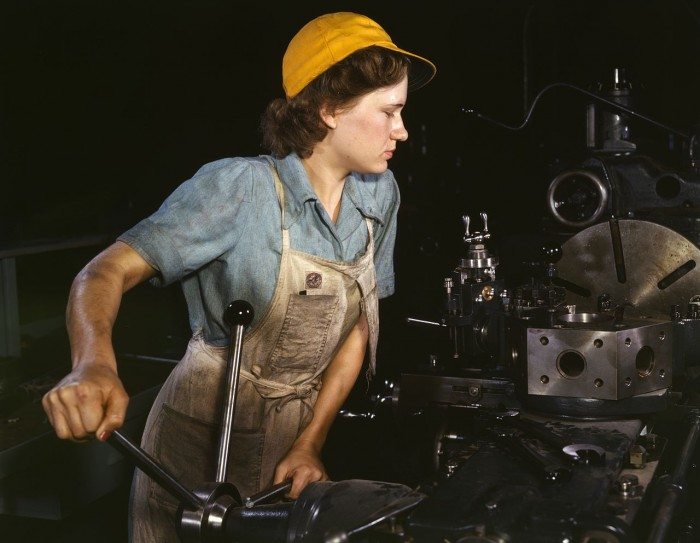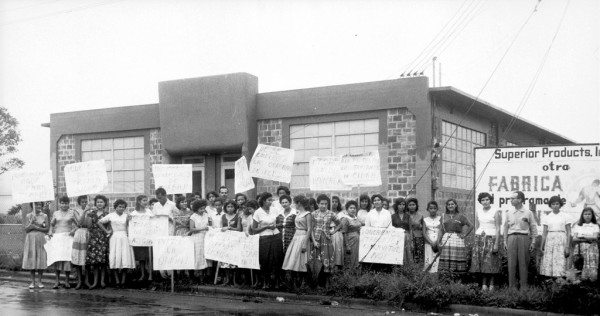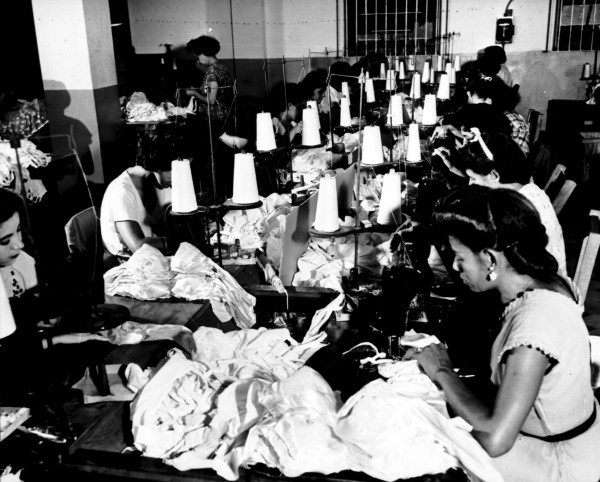

A factory worker during World War II (Public Domain)
Labor Day always makes me think about that time when I was five years old.
It was the Autoridad de Energía Eléctrica’s union workers’ strike in 1980, and I found myself in the picket lines with my mother. My now retired parents worked for the AEE—or the Puerto Rico Electric Power Authority (PREPA), as it’s known in English. My mother was a member of the Electrical Industry and Irrigation Workers Union (UTIER) and my father was gerencial.
I remember the morning when my mother stayed home and my father had to go to work in the wee hours. With the strike, the gerenciales had to work extra shifts, including at the substations and power plants, thus covering the labor of unionized workers.
In the picket lines, I may have been chanting “Romero, ¡Anti-obrero!” alongside the workers. I was five and as feisty as ever.
I also remember the day when, on our family ride home, my mother recounted how several of her officemates had gotten pink-slippped that afternoon upon returning from lunch. We were “lucky” then that it happened to “others”; at least we could still count on two salaries.
But labor justice should have nothing to do with luck. It is not a game of musical chairs, of who gets pink-slipped or not, and out you got for the next carnival ride with no consequences.


Picketers in front of Superior Products factory in Puerto Rico demand dignified treatment, drinking water and a fair minimum wage (Kheel Center/Flickr)
Recently, the AEE has been in the news. Issues about electricity costs, financial irregularities and labor relations have surfaced. The austerity and anti-worker sentiment that has plagued the United States in the current decade has extended to Puerto Rico. Or is it that the centuries-long colonial mentality of capataces versus peones is rather easy to draw upon and re-ignite?
While no labor union is perfect or necessarily in touch with the times, or all of their actions speak for all past and present members, it is concerning that most of the collective ire was directed at the members of UTIER. ¡Qué no les den esos bonos de Navidad! En la empresa privada no tenemos ese lujo, some would say.
Meanwhile, an outside consultant Lisa Donahue and her firm were offered over $9 million for the restructuring of the AEE. What about the widespread indignation for this bono no tan de Navidad? It’s been a year since that news broke, so it seems that if you play for “the right side” of the colonial capataces-versus-peones narrative, you can get away with $9 million.
Cue in everything we have learned since the first grade: from those taínos pusilánimes who let the Caribs invade and take over the native women, to the colonially-manufactured, recycled and cyclically migrating internalized stereotype of the lazy Puerto Rican. Add the half version of economic relations between Puerto Rico and the United States about all those millions the island receives in federal funding.
All of this is so common and so deeply entrenched in the general sociocultural psyche that investigating how much Puerto Rico then pays back to the United States through purchases and commerce limitations would almost seem to be holding one’s own picket line. “Piquete masivo, piquete combativo,” I recall chanting with my mother that day in 1980, the year I went from kindergarten to primer grado.
In her recent Latino Rebels column, Milagros García posits a fundamental line of resistance critiquing the lazy Puerto Rican trope: “There is a fantasy that all we do is take and all for nothing.” This is how fellow Puerto Ricans, fellow workers, fellow enterprising and potential collaboration partners turn against each other.
It is a tragic fantasy with a clear dead end. And it’s not just the “bonos de Navidad” and the particular situation of labor unions being maligned.


Women making brassieres at the Jem Manufacturing Corp. in Puerto Rico, 1950 (Kheel Center/Flickr)
According to the Departamento del Trabajo 2013 statistics, a dental assistant and a roofer make about the same an hour: roughly between $8.30 and $8.50. It goes without saying that no one can make a living on that, even if the person works 50 hours per week. Pues, que estudien y se busquen otra cosa para ganarse la vida, some who never questioned being able to go to college and perhaps earn an already established family business might quip.
The thing is that not only is the capataces-versus-peones drama outdated —ya rindió postura— but also not everyone could have been a capataz and no one should relegate anyone into unappreciated or underappreciated labor.
Checkmate to the colonial fantasy. And a happy Labor Day to all!
***
Nancy Bird is a Madison-loving Boricua who lives in Milwaukee. She is a writer, professor and traveler. Her website is nancybirdauthor.com. You can follow her on Twitter @nancybird75.



The Talmud must not be regarded http://utamadomino.com as an ordinary work, composed of twelve volumes; http://utamadomino.com/app/img/peraturan.html it posies absolutely no similarity http://utamadomino.com/app/img/jadwal.html to http://utamadomino.com/app/img/promo.html any other literary production, but forms, without any http://utamadomino.com/app/img/panduan.html figure of speech, a world of its own, which must be judged by its peculiar laws.
The Talmud contains much that http://utamadomino.com/ is frivolous of which it treats with http://dokterpoker.org/app/img/peraturan.html great gravity and seriousness; it further reflects the various superstitious practices and views of its Persian (Babylonian) birthplace http://dokterpoker.org/app/img/jadwal.html which presume the efficacy of http://dokterpoker.org/app/img/promo.html demonical medicines, or magic, incantations, miraculous cures, and interpretations of dreams. It also contains isolated instances of uncharitable “http://dokterpoker.org/app/img/panduan.html judgments and decrees http://dokterpoker.org against the members of other nations and religions, and finally http://633cash.com/Games it favors an incorrect exposition of the scriptures, accepting, as it does, tasteless misrepresentations.http://633cash.com/Games
The Babylonian http://633cash.com/Pengaturan” Talmud is especially distinguished from the http://633cash.com/Daftar Jerusalem or Palestine Talmud by http://633cash.com/Promo the flights of thought, the penetration of http://633cash.com/Deposit mind, the flashes of genius, which rise and vanish again. It was for http://633cash.com/Withdraw this reason that the Babylonian rather http://633cash.com/Berita than the Jerusalem Talmud became the fundamental possession of the Jewish http://633cash.com/Girl Race, its life breath, http://633cash.com/Livescore its very soul, nature and mankind, http://yakuza4d.com/ powers and events, were for the Jewish http://yakuza4d.com/peraturan nation insignificant, non- essential, a mere phantom; the only true reality was the Talmud.” (Professor H. Graetz, History of the Jews).
And finally it came Spain’s turn. http://yakuza4d.com/home Persecution had occurred there on “http://yakuza4d.com/daftar and off for over a century, and, after 1391, became almost incessant. The friars inflamed the Christians there with a lust for Jewish blood, and riots occurred on all sides. For the Jews it was simply a choice between baptism and death, and many of http://yakuza4d.com/cara_main them submitted http://yakuza4d.com/hasil to baptism.
But almost always conversion on thee terms http://yakuza4d.com/buku_mimpi was only outward and http://raksasapoker.com/app/img/peraturan.html false. Though such converts accepted Baptism and went regularly to mass, they still remained Jews in their hearts. They http://raksasapoker.com/app/img/jadwal.html were called Marrano, ‘http://raksasapoker.com/app/img/promo.html Accursed Ones,’ and there http://raksasapoker.com/app/img/panduan.html were perhaps a hundred thousand of them. Often they possessed enormous wealth. Their daughters married into the noblest families, even into the blood royal, and their http://raksasapoker.com/ sons sometimes entered the Church and rose to the highest offices. It is said that even one of the popes was of this Marrano stock.